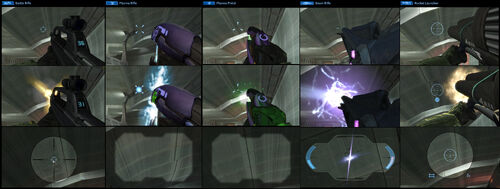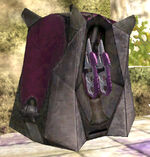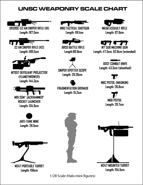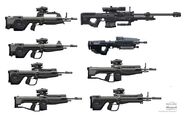- For the AI known as the Weapon, see The Weapon.
Weapons within the Halo Universe form the basis for the gameplay featured in the video games.
Overview[]
The player is allowed to use weapons from many races, such as Humans, Covenant, and Forerunner, often turning the enemy's firepower against them.
Humanity's weapons tend to utilize mostly projectile weapons; bullets, but also explosives, railguns, and lasers. Covenant weapons are generally plasma or energy-based, with the exception of Brute weapons, which use spikes or explosives. All plasma weapons use charge. All weapons run out of ammunition or charge when used extensively. Covenant weapons typically overheat if fired continuously for long periods of time, which causes your weapon to become temporarily unresponsive. Forerunner weapons eject Hard light rounds or another, unnamed type of ammunition (used in the Scattershot and Binary Rifle), which causes disintegration of biomass upon impact.

|

|

|
|||
| UNSC Weaponry |
Covenant Weaponry |
Forerunner Weaponry |
Gameplay[]
An extensive array of weapons is available within the gameplay, with each weapon operating differently. This allows players to take a different approach and sometimes forces a change in tactics depending on the strengths and weaknesses of each weapon. Each player will also find a weapon to suit his or her tastes, in terms of power, speed, range, kickback and/or feedback. For example, a player who is suited with sniping might have the Sniper rifle, Beam Rifle, DMR, Battle rifle, Covenant Carbine, or Focus Rifle as their favorite.
Usage[]
Halo: Combat Evolved limited the number of weapons players could carry to two (of which only one could be used at any one time), forcing players to carefully select their preferred armament.[1] Players fight with ranged and melee attacks, as well as a limited number of grenades. Bungie refers to the "weapons-grenades-melee" format as the "Golden Triangle of Halo,"[2] which has remained fundamentally unchanged throughout the trilogy. The player character's health is measured in both hit points and a continually recharging energy shield.[3] The energy shield absorbs a significant portion of enemy fire until it becomes depleted, after which the player character will sustain damage, eventually causing death.
Halo 2 introduced new gameplay elements, most notably the ability to hold and fire two weapons simultaneously, known as "dual wielding." The health system was altered in this game, with the player no longer having hit points as well as shields. The Assault Rifle was not included in this game, and was instead replaced by the newly introduced M7 Caseless Submachine Gun .[4]
Halo 3 adds to the series new weapons, kept the dual wielding system, and a class of items called Equipment. The Assault Rifle returns in this incarnation, albeit with a decreased magazine capacity and overall ammo, but with more damage per hit.[5]
Halo 3: ODST adds suppressed caseless M7, namely the Silenced SMG and the Suppressed Auto Mag, replacing the normal versions. Also, the game does not contain the Battle Rifle, Energy Sword, Sentinel Beam, equipment, or dual wielding. Halo 3: ODST also marks the return of the Brute Plasma Rifle, replacing the regular version.[6]
Halo: Reach refined many weapons for both Human and Covenant sides, weapons systems were streamlined and most human weapons in particular were designed to fit combat at a certain range which defined their role. Reach drifted away from the dual wielding system. Reach also introduced three new weapon mechanics, first is reticle bloom; a part of the weapon's crosshair that indicates how accurate or inaccurate a weapon will be depending on the rate of fire. With the semi-auto weapons the faster the trigger is pulled, the less accurate it would become. With full auto weapons the longer the trigger is held down the less accurate the shot pattern will be, short controlled burst can be used to retain accuracy beyond the weapons effective range. The second weapon mechanic introduced was turret overheating, most turrets with unlimited ammo like the machine gun turret and the Warthog turret will over heat after prolonged periods of continuous fire; when a turret overheats it will become inoperative for a short time in order to cool down much like many plasma weapons, this makes firing in accurate bursts important. The final change is the inclusion of assassinations, where an extended attack animation is activated when the player holds down the melee attack button while approaching from behind. Furthermore, Reach introduced a new factor to battles. While equipment from Halo 3 was removed, it was replaced by Armor Abilities . These abilities offered active actions to the Spartan, some of which were similar to equipment (Active Camouflage , Drop Shield etc.), and some that are entirely new (Sprint, Armor Lock , Jetpack etc.) As far as weapon selection goes, Reach is fairly similar to Halo 3 except a few weapons have been added, replaced and removed, notably the replacement of the BR55 Battle Rifle Series with the newly introduced Designated Marksman Rifle (DMR) . The most noticeable removal of all were brute weapons except the Gravity Hammer and the Spiker. Even the Spike grenade was removed.
Halo 4 added 3 new weapons for the UNSC, 1 for the Covenant, and a new system of weapons for the Forerunner race. The newest UNSC weapons are all in the power weapon class and consist of the SAW, Railgun, and Sticky Detonator. Halo 4 also brought back the Battle Rifle, with a vertical recoil as opposed to reticle bloom- the DMRs reticle bloom was changed as well. One new weapon was added to the Covenant arsenal, the Storm Rifle, as a replacement to the Plasma Rifle . The addition of the Forerunner race included a new set of advanced weapon systems specially designed for combating the Flood. These weapons are all hard-light based and some disintegrate the opponents when killed with them, making them impossible to be taken over by the Flood. Halo 4 also introduces Tactical Packages & Support Packages that offer passive abilities to a Spartan whether by altering a Spartan's general performance (quicker movement, silent steps etc.) or by altering the performance of a weapon (Reload Speeds, increased ammo capacity etc.). Halo 4 advanced the use of Sprinting from an active armor ability, to a general trait to all Spartans.
Aiming[]

A few weapons that are displayed in-game, with icon and name, from Halo 2. Screenshots per weapon are when normal, firing, and when in scope/zoomed view.
The typical arrow cursor is hidden within gameplay, and replaced with a blue targeting reticle that stays locked to the center of the screen, when in first-person and third-person views. The reticle turns red when a shot will hit an enemy target and green for allies.
Many weapons are scoped and have the capability to zoom 2x or 5x into any area, with some long range weapons even capable of reaching up to 10x magnification such as the Sniper Rifle. These always show the reticle and continue scoping after shots are fired.
While wielding non-scoped weapons, the player's armor has the capability to zoom, to a minimal extent. These hide the reticle when in the zoomed view, returning to the normal view after every shot, making them inefficient for sniping. However, skilled players can use this in online gameplay to keep a good eye on enemies or destinations.
Types[]
The types of available weapons follow the basic standards present in real life, assault, battle, and sniping.
Grenades are frequently made available, primarily for anti-infantry combat. Some grenades can stick and some grenades are stronger than others.
Melee attacks are always available; if the player is able to get in range of an enemy, that can cause heavy damage. And melee attacks are deadly when you hit an enemy in the back, this will kill every enemy except for hunters . Most times, a single melee attack is sufficient to completely deplete an enemy's shields. These are also used to take control of an enemy vehicle, by melee attacking the craft, then planting a grenade to kill its driver and destroy the vehicle.
Heavy weapons, such as turrets, are also present within Halo levels, either stationary, or mounted on vehicles. Some turrets can be removed from their stands and used as handheld Support Weapons, but it makes the player move slower and gives the turrets limited ammunition. Only when driving a vehicle and controlling a support weapon does the game switch into a third-person view. Some vehicles, such as the Ghost, Scorpion Tank, and Banshee allow the driver to directly control mounted weapons while driving the vehicle. Other multi-occupant vehicles such as the Warthog require the player to remain in the weapon seat to control fire and driving seat to control navigation.
Explosives and large scale weapons, missiles, Nuclear Weapons, and Halos are usually involved in the storyline of every game, though not usually used.
Availability[]

A Covenant Supply Case containing two Covenant Carbines.
Within campaign levels, the player's character always begins with two weapons, and will always have access to weapons lying around, either near corpses or within weapon caches and stores.
Killed enemies or allies can be robbed of their dropped weapons as well. In Halo 2 and onwards, the player can exchange weapons with allied AI when requested, making it unnecessary to kill them only to use their weapons, although grenades still cannot be traded.
Weapons can be reloaded by collecting ammunition or swapping the player character's weapon with a loaded dropped weapon. If the player is already wielding the same weapon, they can swap if the new weapon is loaded or charged more than the wielded weapon.
Certain weapon types usually have more or less ammunition available. For instance, sniper rifles, a weapon intended for long-range combat, typically have less ammunition lying around then assault or battle rifles, which, in contrast, are intended as primary/multipurpose weapons.
Common Tips[]
- In multiplayer, shooting a player's weapon will cause them to take damage and can even kill them. It is also possible to stick a plasma or stick grenade to their weapons.
- A good trick to find snipers is to watch for the smoke left behind from the weapon's tracer bullets.
- To avoid or spot enemy 'campers', one can watch for gun barrels sticking out from behind walls, barriers, and other common 'camping' spaces.
- For Halo: Reach, avoid high rates of fire when using a Magnum, DMR, or the Needle Rifle for better attack damage. A DMR will produce the same amount of damage as a Magnum, but the Magnum is best at close encounters (the Magnum's reticle bloom is extremely large).
- Simply running towards your enemy and shooting at the same time is not a good tactic. Strafing is a better alternative.
- Try shooting the head, not the body when using headshot capable weapons. Conversely, aim for the chest when using strictly close-ranged weapons (Shotgun, Magnum, etc.)
- When using explosives, aim for the feet of the enemy as a body shot could be easily evaded.
- Snipers that stay in tight spaces will be vulnerable to explosives and grenades due to lack of room to move.
- Fire in short bursts with automatic weapons, such as the assault rifle, as it is a good way to maintain accuracy.
- While using a rocket launcher attempting to hit the opponent on the head or body is very difficult. Shoot nearby objects (like the ground or wall) as the resulting blast is harder to dodge.
- Not every shot you fire has to be to kill. Simply keeping targets under pressure, forcing them to stay behind cover, can be quite effective, especially if you have clever or skillful teammates.
- If you chase an enemy behind a corner, it may not be the best idea to continue pursuing them unless you have a good close-ranged weapon.
- If you spot an enemy it is most likely he/she also spotted you. Take action.
Trivia[]
- The Marathon symbol can be observed on most if not all human weapons. It is very small and often blends in and is better observed zoomed in close up. For example, it can be found located on the back of the MA5C Assault Rifle as well as on the Sniper Rifle close to the gun's trigger.
- Halo 4 is the first Halo game to introduce weapon skins.





